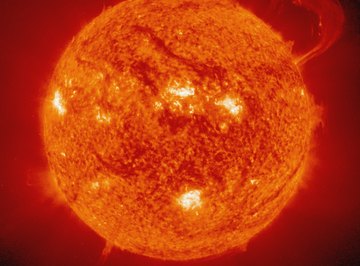
Our sun, like every other star, is a gigantic ball of glowing plasma. It’s a self-sustaining thermonuclear reactor that provides the light and heat our planet needs to sustain life, while its gravity keeps us (and the rest of the solar system) from spinning off into deep space.
The sun contains several gases and other elements that give off electromagnetic radiation, allowing scientists to study the sun despite not being able to access physical samples.
TL;DR (Too Long; Didn't Read)
The most common gases in the sun, by mass, are: hydrogen (about 70 percent, helium (about 28 percent), carbon, nitrogen and oxygen (together about 1.5 percent). The remainder of the sun’s mass (0.5 percent) is made up of a mixture of trace amounts of other elements, including but not limited to neon, iron, silicon, magnesium and sulfur.
The Sun’s Composition
Two elements make up the overwhelming majority of the sun’s matter, by mass: hydrogen (about 70 percent) and helium (about 28 percent). Note, if you see different numbers, don’t fret; you’re probably seeing estimates according to the total number of individual atoms. We’re going by mass because it’s easier to think about.
The next 1.5 percent of mass is a mix of carbon, nitrogen and oxygen The final 0.5 percent is a cornucopia of heavier elements, including but not limited to: neon, iron, silicon, magnesium and sulfur.
How Do We Know What the Sun Is Made Of?
You may be wondering how, exactly we know what makes up the sun. After all, no human has ever been there and no spacecraft has ever brought back samples of solar matter. The sun, however, is constantly bathing the earth in electromagnetic radiation and particles released by its fusion-powered core.
Every element absorbs certain wavelengths of electromagnetic radiation (i.e., light), and likewise emits certain wavelengths when heated. In 1802, scientist William Hyde Wollaston noticed that sunlight passing through a prism produced the expected rainbow spectrum, but with notable dark lines scattered here and there.
To get a better look at this phenomena, optician Joseph von Fraunhofer, invented the first spectrometer – basically an improved prism – that spread the different wavelengths of sunlight out even more, making them easier to see. It also made it easier to see that Wollaston's dark lines weren't a trick or illusion – they seemed to be a feature of sunlight.
Scientists figured out that those dark lines (now called Fraunhofer lines) corresponded to the specific wavelengths of light absorbed by certain elements like hydrogen, calcium and sodium. Therefore, those elements must be present in the outer layers of the sun, absorbing some of the light being emitted by the core.
Over time, increasingly sophisticated detection methods have allowed us to quantify the output from the sun: electromagnetic radiation in all its forms (X-rays, radio waves, ultraviolet, infrared and so on) and the flow of subatomic particles like neutrinos. By measuring what the sun releases and what it absorbs, we've built a very thorough understanding of the sun's composition from afar.
Getting Nuclear Fusion Started
Did you happen to notice any patterns in the materials that make up the sun? Hydrogen and helium are the first two elements on the periodic table: the simplest and lightest. The heavier and more complex an element, the less of it we find in the sun.
This trend of decreasing amounts as we move from lighter/simpler to heavier/more complex elements reflects how stars are born and their unique role in our universe.
In the immediate aftermath of the Big Bang, the universe was nothing more than a hot, dense cloud of subatomic particles. It took almost 400,000 years of cooling and expanding for these particles to come together in a form we’d recognize as the first atom, hydrogen.
For a long time, the universe was dominated by hydrogen and helium atoms that were able to form spontaneously within the primordial subatomic soup. Slowly, these atoms begin to form loose aggregations.
These aggregations exerted greater gravity, so they kept growing, pulling in more material from nearby. After about 1.6 million years, some of these aggregations got so big that the pressure and heat in their centers were were enough to kick off thermonuclear fusion, and the first stars were born.
Nuclear Fusion: Turning Mass Into Energy
Here’s the key thing about nuclear fusion: even though it requires a tremendous amount of energy to get started, the process actually releases energy.
Consider the creation of helium via hydrogen fusion: Two hydrogen nuclei and two neutrons combine to form a single helium atom, but the resulting helium actually has 0.7 percent less mass than the starting materials. As you know, matter can be neither created nor destroyed, so that mass must have gone somewhere. In fact, it was transformed into energy, according Einstein’s most famous equation:
In which E is energy in joules (J), m is mass kilograms (kg) and c is the speed of light in meters/second (m/s) – a constant. You could put the equation into plain English as:
energy (joules) = mass (kilograms) × speed of light (meters/second)2
The speed of light is roughly 300,000,000 meters/second, which means c2 has a value of approximately 90,000,000,000,000,000 – that’s ninety quadrillion – meters2/second2. Normally when dealing with numbers this big, you’d put them in scientific notation to save space, but it’s useful here to see just how many zeroes you’re dealing with.
As you can imagine, even a tiny number multiplied by ninety quadrillion is going end up very large. Now, let’s look at single gram of hydrogen. To make sure the equation gives us an answer in joules, we’ll express this mass as 0.001 kilograms – units are important. So, if you plug in these values for mass and speed of light:
That’s close to the amount of energy released by the nuclear bomb dropped on Nagasaki contained within a single gram of the smallest, lightest element. Bottom line: The potential for energy generation by converting mass to energy via fusion is mind-boggling.
This is why scientists and engineers have been trying to figure out a way to create a nuclear fusion reactor here on Earth. All of our nuclear reactors today work via nuclear fission, which splits atoms into smaller elements, but is a much less efficient process for converting mass into energy.
Gases on the Sun? Nope, Plasma
The sun doesn’t have a solid surface like the earth’s crust – even setting aside the extreme temperatures, you couldn’t stand on the sun. Instead, the sun is made up of seven distinct layers of plasma.
Plasma is the fourth, most energetic, state of matter. Heat up ice (solid), and it melts into water (liquid). Keep heating it, and it changes again into water vapor (gas).
If you keep heating that gas, though, it will become plasma. Plasma is a cloud of atoms, like a gas, but it has been infused with so much energy that it has been ionized. That is, its atoms have become electrically charged by having their electrons knocked loose from their usual orbits.
The transformation from gas to plasma changes a substance’s properties, and the charged particles often release energy as light. Glowing neon signs, in fact, are glass tubes filled with a neon gas – when a electrical current is passed through the tube, it causes the gas to transform into a glowing plasma.
The Structure of the Sun
The sun’s spherical structure is a result of two constantly competing forces: gravity from the dense mass at the sun’s center trying to pull all of its plasma inward versus energy from the nuclear fusion taking place in the core, causing the plasma to expand.
The sun is made up of seven layers: three inner and four outer. They are, from the center outward:
- Core
- Radiative zone
- Convective zone
- Photosphere
- Chromosphere
- Transition region
- Corona
The Layers of the Sun
We’ve talked about the core a lot already; it is where fusion takes place. As you’d expect, it’s where you’ll find the highest temperature on the sun: some 27,000,000,000 (27 million) degrees Fahrenheit.
The radiative zone, sometimes called the “radiation” zone, is where energy from the core travels outward primarily as electromagnetic radiation.
The convective zone, aka “convection” zone, is where the energy is carried primarily by currents within the layer’s plasma. Think of how vapor from a boiling pot carries heat from the burner up into the air above the stove, and you’ll have the right idea.
The “surface” of the sun, such that it is, is the photosphere. This is what we see when we look at the sun. The electromagnetic radiation emitted by this layer is visible to the naked eye as light, and it’s so bright that it hides the less dense outer layers from view.
The chromosphere is hotter than the photosphere, but it's not as hot as the corona. Its temperature causes hydrogen to emit reddish light. It’s usually invisible but can be seen as a reddish glow surrounding the sun when a total eclipse hides the photosphere.
The transition zone is a thin layer where temperatures shift dramatically from the chromosphere to the corona. It’s visible to telescopes that can detect ultraviolet (UV) light.
Finally, the corona is the outermost layer of the sun and is extremely hot – hundreds of times hotter than the photosphere – but invisible to the naked eye except during a total eclipse, when it appears as a thin white aura around the sun. Exactly why it’s so hot is a bit of a mystery, but at least one factor seems to be “heat bombs”: packets of extremely hot material that float up from deep in the sun before exploding and releasing energy into the corona.
Solar Wind
As anybody who’s ever had a sunburn can tell you, the effects of the sun extend far beyond the corona. In fact, the corona is so hot and distant from the core that the sun’s gravity can’t keep a hold on the super-heated plasma – charged particles stream off into space as a constant solar wind.
The Sun Will Eventually Die
Despite the sun’s incredible size, it will eventually run out of the hydrogen it needs to sustain its fusion core. The sun is has a predicted total lifespan of around 10 billion years. It was born about 4.6 billion years ago, so there’s quite a while before it will burn out, but it will.
The sun radiates an estimated 3.846 × 1026 J of energy every day. With that knowledge, we can estimate how much mass it must be converting on a per-second basis. We’ll spare you more math for now; it comes out to around 4.27 × 109 kg per second. In just three seconds, the sun consumes about as much mass as makes up the Great Pyramid of Giza, twice over.
When it runs out of hydrogen, it will begin to use its heavier elements for fusion – a volatile process that will make it expand to 100 times its current size while spewing much of its mass into space. When it finally exhausts its fuel, it will leave behind a small, extremely dense object called a white dwarf, about the size of our Earth but many, many times more dense.
References
About the Author
Kenrick Vezina is a writer, editor, and educator whose career highlights include writing for National Geographic, co-developing an online science-writing course for MIT, and pulling a kid out of chest-deep mud in a salt marsh. He loves animals and alliteration.
